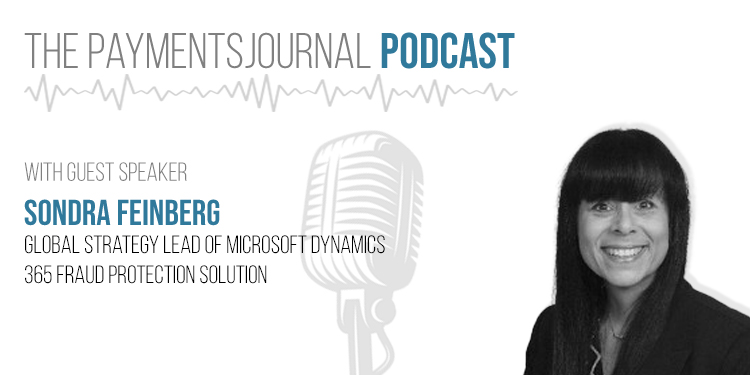Podcast: Play in new window | Download
With the increasing sophistication of cybercriminals, fraud prevention is more important than ever before. To combat this sophistication, merchants and businesses need to equip themselves with a fraud prevention solution that utilizes cutting-edge technology.
In an interview with PaymentsJournal at the 2021 Money20/20 event, Sondra Feinberg, Global Strategy Lead of Microsoft Dynamics 365 Fraud Protection Solution, spoke about Microsoft’s mission to empower every person and organization on the planet to achieve more, and how its fraud prevention solution is doing just that.
The problem: Unique forms of fraud are emerging
An alarming aspect of today’s fraud landscape is that unique fraud types are continuously arising. “There are types of fraud that we’ve never seen before,” said Feinberg. Three major types of fraud have come to light in recent years:
- Bandwagon fraud. In instances of bandwagon fraud, an influencer or pop culture icon may advertise a product (e.g., a hair dryer). Their followers jump on the bandwagon and buy the item, but then the influencer switches gears and says they don’t recommend the product after all. Their followers then do the same, and chargebacks for that particular item come flooding in.
- Green fraud. In instances of green fraud, consumers order merchandise that is advertised as environmentally friendly or green. When they receive the product, they find that it does not meet their ethical requirements–perhaps the ingredients contain synthetic materials they weren’t aware of–and return it for a chargeback.
- Empathy fraud. In instances of empathy fraud, consumers attempt to tug on the heartstrings of customer service representatives to obtain free goods or services. Feinberg used an Xbox subscription to highlight how this can play out: a customer service representative receives a phone call from a child claiming that their parent lost their job due to COVID-19 and requesting a free subscription extension. Little does the representative know, the caller is actually an adult consumer attempting to get free goods. Empathizing with who they perceive to be a child, they approve the free extension.
The solution: Dynamics 365 Fraud Protection
As a top ten e-commerce company, Microsoft has had its share of fraudsters trying to infiltrate its ecosystem. In the past, the company relied on third-party fraud vendors for protection, but felt over time that its partners were not as effective as they should be. Six years ago, Microsoft decided to develop its own tool to prevent fraud.
“We put a bunch of engineers in a room and, lo and behold, we came out with a fantastic fraud protection solution. We’ve been using it internally at Microsoft for the last four years and we commercialized it about two years ago. The reason that is important is because as Microsoft is both a provider and user of the same fraud technology, it gives us a very unique perspective into the marketplace and what retailers and merchants need from a fraud solution itself,” said Feinberg.
Dynamics 365 Fraud Prevention (DFP) is a pre-authorization solution that uses Adaptive AI technology with BOT detection and device fingerprinting to track and identify fraud. The solution uses pre-authorization risk scoring to determine the validity of a transaction for Microsoft’s bank partners. The feature that sets this solution apart from others in the market is its transaction acceptance booster, which provides a direct communication channel for contextual transaction data with participating issuing banks and networks.
“Our fraud solution is designed to share contextual transaction knowledge with our banking partners. What that means is most banks have a limited amount of information about a transaction before they approve or decline a transaction. With DFP, we can share additional risk details with the bank in a compliant and secure way,” she added.
A DFP success story: Capital One Bank
Microsoft’s partners have already had success after adopting DFP. “When somebody comes through and wants to check out on a particular website, we are able to share the risk score with the bank, let’s say Capital One, ahead of the payment being processed through the gateway and payment processors,” explained Feinberg.
A Capital One case study found that Microsoft’s intelligence has reduced false positives by 45% and overall fraud flowing through the bank by 15%. “Those numbers are absolutely phenomenal. When you think about the trust that they have in our data and our risk scoring mechanism, when we look at doing that for other financial institutions, it really creates a 360-degree view of the transaction and the entity behind the transaction,” added Feinberg.
Reducing manual review rates
Another noteworthy aspect of Microsoft’s fraud solution is that it enables companies to drastically reduce their manual transaction review rate. This saves the time, money, and internal resources typically needed to conduct manual reviews. Using its own solution, Microsoft reduced its manual review rate by 82% to just 0.3%. Some of its partners, including Xbox, rely 100% on Microsoft’s risk scoring mechanism and have eliminated manual reviews entirely.
\
Other Key Performance Indicators (KPI) improved as well, with the false positive and fraud loss rates declining, and bank acceptance rates increasing.
The takeaway
By taking data out of siloes, organizations can have a better holistic picture of a consumer’s behavior and risk. Microsoft’s predictive chargeback signals make this possible.
“When you talk about data in silos and you talk about retail, it’s not just worrying about retail. You have to worry about an entire ecosystem because fraudsters like to move laterally. They’ll attack gaming, then they’ll go to retail, then they’ll go to a restaurant, and then they’ll go to a state or [even] the national government. You have to be able to take all those different data positions and feed it and look for those patterns. That’s done by machine learning and AI to come up with those risk scoring mechanisms,” Feinberg concluded.
